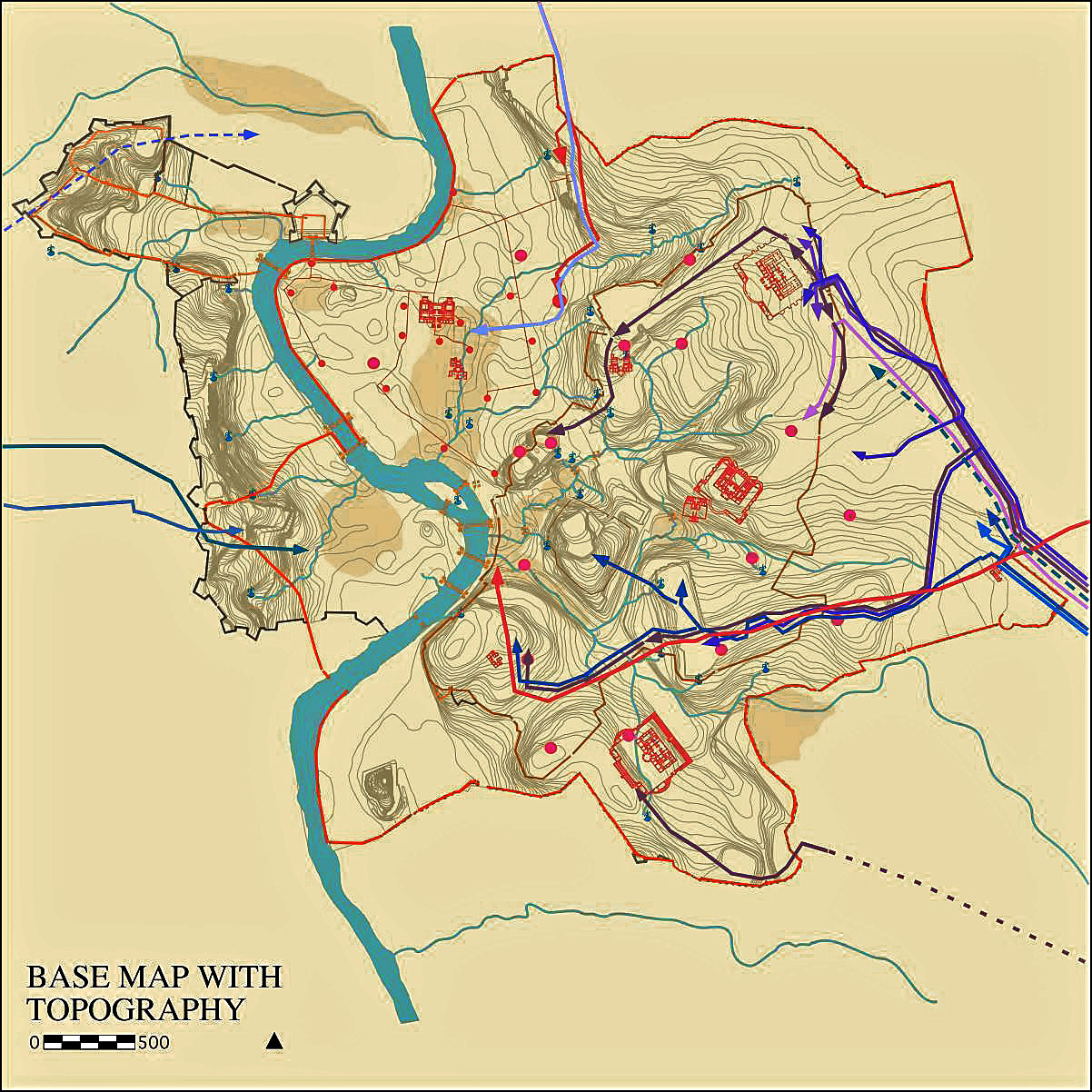
The
Fountains of Rome
The locations of all places are shown on my Google-Earth Map
Respighi
"The Fountains of Rome" (YouTube,
10 min)
Images
of Rome set to the famous symphonic poem by the Italian composer
Ottorino Respighi. Chicago Symphony directed by Fritz Reiner.
A
History of Rome's Fountains
For
more than two thousand years fountains have provided drinking water
and decorated the piazzas of Rome. During the Roman Empire, the Roman
consuls were the "curatores aquarum" or guardians of the
water of the city. Rome had nine aqueducts which fed 39 monumental
fountains and 591 public basins, not counting the water supplied to
the Imperial household, baths and owners of private villas. Each of
the major fountains was connected to two different aqueducts, in case
one was shut down for service.
After the fall of the Roman Empire, the aqueducts fell into
disrepair, and the fountains stopped working. In the 14th century,
Pope Nicholas V (1397–1455) decided to embellish the city and make
it a worthy capital of the Christian world.
In 1453 he began to
rebuild the Acqua Vergine, the aqueduct which had brought clean
drinking water to the city from eight miles (13 km) away. He also
decided to revive the Roman custom of marking the end point of an
aqueduct with a mostra, a grand commemorative fountain.
He
commissioned the architect Leon Battista Alberti to build a fountain
where the Trevi Fountain is now. The aqueduct he restored, with
modifications and extensions, eventually supplied water to the Trevi
Fountain and the famous baroque fountains in the Piazza del Popolo
and Piazza Navona.
During the 17th and 18th century the Popes reconstructed other ruined
Roman acqueducts and built new display fountains to mark their
termini, launching the golden age of the Roman fountain.
The
fountains of Rome, like the paintings of Rubens, celebrated the
Counter Reformation with the exuberant flourishes of Baroque art.
They were crowded with allegorical figures, and filled with emotion
and movement. In these fountains, sculpture became the principal
element, and the water was used simply to animate and decorate the
sculptures. They, like baroque gardens, were a visual representation
of the confidence and power of the Popes and the Church.
The Aqueducts of Rome
The aqueducts, besides Rome's military prowess, are the great achievements of ancient Roman civilisation. They built them all over the Empire, but those that fed the capital with fresh water were the most impressive engineering feat.

The aqueducts of Rome, original map by Katherine
Rinne, This copy from:
Prof.Sijpkes arch.mcgill.ca
An overlay copy of this map is
found on my Google-Earth
Map
I was lucky to discover this map on a website of Mc Gill University - it is not easy to find information on this subject. The red dots represent public fountains, the blue springs, and the red structures the imperial baths. Seven parallel aqueducts arrive from the Roman Campangna along Via Appia. Ruins of them still cross the beautiful landscape. They date back as far as the 4th cent BC.
List of the most important aqueducts in Rome:
1.In 312 BC, the Via
Appia Aqueduct was built 16.4 km long.
2.Anio Verus, built
between 272-269 BC and 63.7 km.
3.Marcia, built between 144-140 BC
and 91.4 km.
4. Tepula, built in 125 BC, and 17.7 km.
5. Julia
built in 33 BC at 22.8 km.
6. Virgo built in 19 BC, at 20.7 km.
7.
Alsientina, whose date is unknown. Its length is 32.8 km.
8.The
last two aqueducts were built between 38 and 52 A.D. Claudia was 68.8
km
9.and Anio Novus was 87.0 km.
Parco degli 7 Acquedotti
off
Via Appia, west of Cine Citta
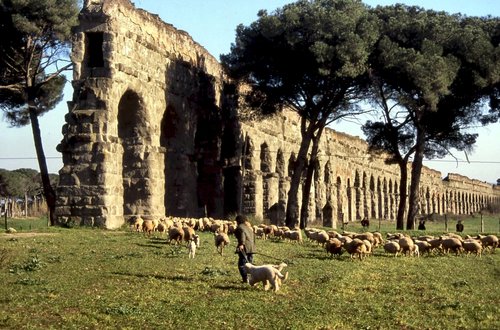
Acqueduct Marcia in the Campagna
One of the most beautiful parts of the Roman Campagna. Take bicycles,
there is a path
Station on Metro A-line: Subaugusta, also on FR4
and FR6.
Fontana
Trevi
In
the very center of Rome, 1732-1762

“Dolce Vita” Anita Ekberg and Marcello Mastroianni - in the Trevi Fountain 1960
The Trevi Fountain is the largest and most spectacular of Rome's fountains, designed to glorify the three different Popes who created it. It was built beginning in 1730 at the terminus of the reconstructed Acqua Vergine aqueduct, on the site of a Renaissance fountain by Leon Battista Alberti. It was the work of architect Nicola Salvi and the successive project of Pope Clement XII, Pope Benedict XIV and Pope Clement XIII, whose emblems and inscriptions are carried on the attic story, entablature and central niche. The central figure is Oceanus, the personification of all the seas and oceans, in an oyster-shell chariot, surrounded by Tritons and Sea Nymphs.
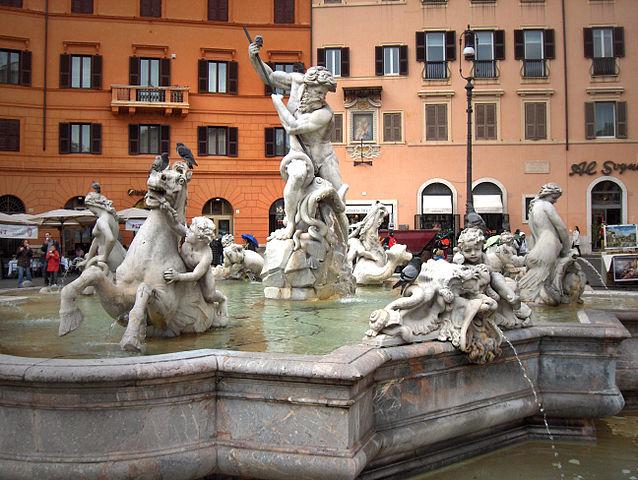
The Fontana del Nettuno, (without the sculptures) was designed in
1574 by Giacomo Della Porta, who also designed the Moor Fountain at
the other side of the square. It was sponsored by pope Gregory XIII.
The lower part of the basin consists of white marble and the upper
part of the local stone from Pietrasanta. For the next 300 years, the
fountain survived without statues.
The fountain as it exists today
was finally completed in 1878 by Antonio della Bitta, who added the
imposing sculpture of "Neptune fighting with an octopus"
and Gregorio Zappalà, who created the other sculptures, based on the
mythological theme of the "Nereids with cupids and walruses".
Statuary was added following a competition in 1873
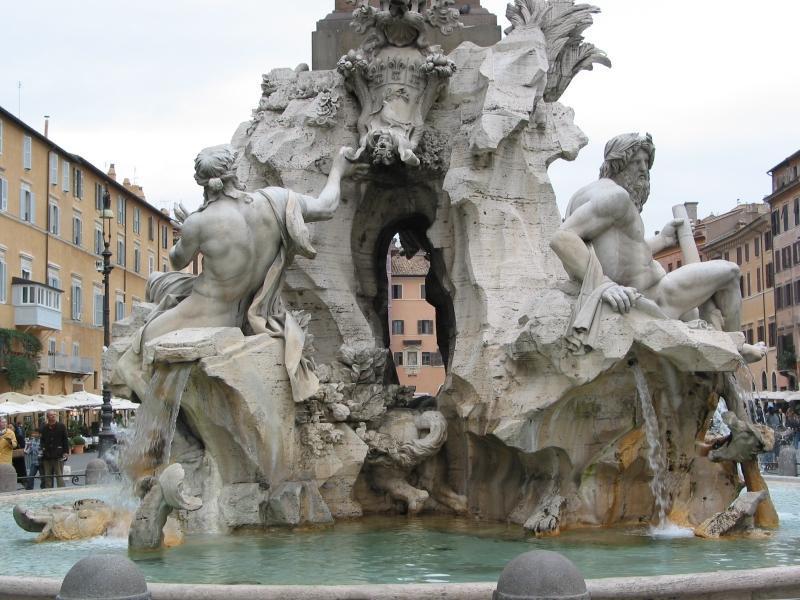
TThe Fontana dei Quattro Fiumi or "Fountain of the Four Rivers" is located in the center of Piazza Navona. It was designed in 1651 by Gian Lorenzo Bernini for Pope Innocent X whose family palace, the Palazzo Pamphili, faced onto the piazza as did the church of Sant'Agnese in Agone of which Innocent was the sponsor.
The base of the fountain is a basin from the centre of which travertine rocks rise to support four river gods and above them, an ancient Egyptian obelisk surmounted with the Pamphili family emblem of a dove with an olive twig. The coat of arms of the Pamphili is seen in the photo. The obelisk which tops the group has been omitted. Collectively, they represent four major rivers of the four continents through which papal authority had spread: the Nile representing Africa, the Danube representing Europe, the Ganges representing Asia, and the Plate representing the Americas.
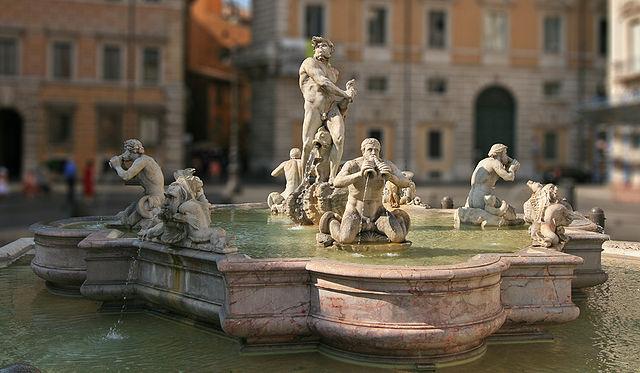
Perhaps the lovelieat of the three fountains. It was originally designed by Giacomo della Porta in 1575 with the dolphin and four Tritons. In 1653, the statue of the Moor, by Gian Lorenzo Bernini, was added. In 1874, during a restoration of the fountain, the original statues were moved to the Villa Borghese and replaced with copies.

At the center of Piazza di Spagna, at the bottom of the Spanish Steps, this curious, half-sunken boat gently spills out water rather than cascading it dramatically into the air; it may have been designed that way to make the most of the area's low water pressure. It was thanks to the Barberini pope Urban VIII, who commissioned the fountain, that there was any water at all in this area, which was becoming increasingly built up during the 17th century. He restored one of the ancient Roman aqueducts that once channeled water here. The bees and suns on the boat constitute the Barberini motif. Some insist that the Berninis (Pietro and his more famous son Gian Lorenzo) intended the fountain to be a reminder that this part of town was often flooded by the Tiber; others that it represents the Ship of the Church; and still others that it marks the presumed site of the emperor Domitian's water stadium in which sea battles were reenacted in the glory days of the Roman Empire.

The Triton Fountain in the Piazza Barberini (1642), by Gian Lorenzo Bernini, is a masterpiece of Baroque sculpture, representing Triton, half-man and half-fish, blowing his horn to calm the waters, following a poem by Ovid in the Metamorphoses

Fountain of the Bees" The Fontana delle Api in the Piazza Barberini iwhere the piazza meets Via Sistina is by Gian Lorenzo Bernini completed in April 1644.

The Fountain is believed to be the oldest in Rome, dating back, according to some sources, to the 8th century. The present fountain is the work of Donato Bramante, with later additions by Gian Lorenzo Bernini and Carlo Fontana
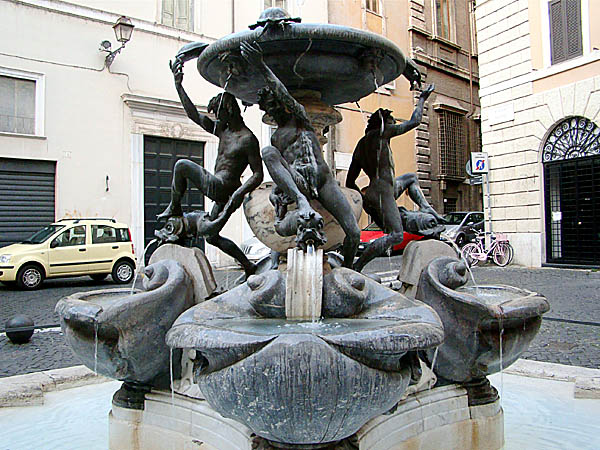
The
Fontane delle Tartarughe (The Turtle Fountain) is located in the
Piazza Mattei, in the Sant'Angelo district of Rome. It was built
between 1580 and 1588 by the architect Giacomo della Porta and the
sculptor Taddeo Landini. The bronzes turtles around the upper basin,
usually attributed either to Gian Lorenzo Bernini or Andrea Sacchi,
were added in either 1658 and 1659, when the fountain was restored.
In 1588, the writer Girolamo
Ferrucci called it "the most graceful and perfect fountain in
Rome."
The
turtles are not very large, they peer over the rim of the upper bowl
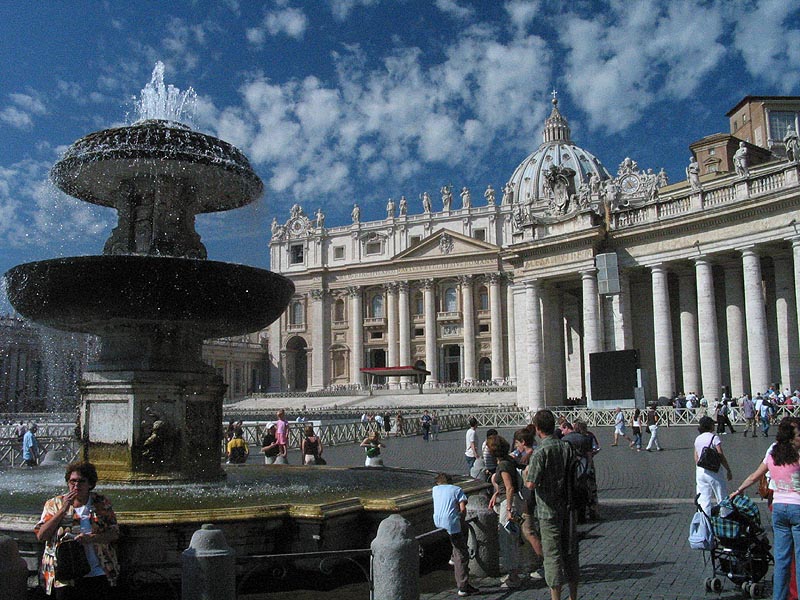
In 1612, the ancient Roman aqueduct the Aqua Traiana was rebuilt by Pope Paul V and renamed the Acqua Paola; the restored aqueduct provided the fountain with a much more abundant source of water. The architect Carlo Maderno, nephew of the architect Domenico Fontana, was given the commission to redesign the fountain. Like all fountains of the time, the fountain on St. Peter's Square had no pumps and operated purely by gravity, with a source of water higher than the fountain which caused the water to shoot upwards.
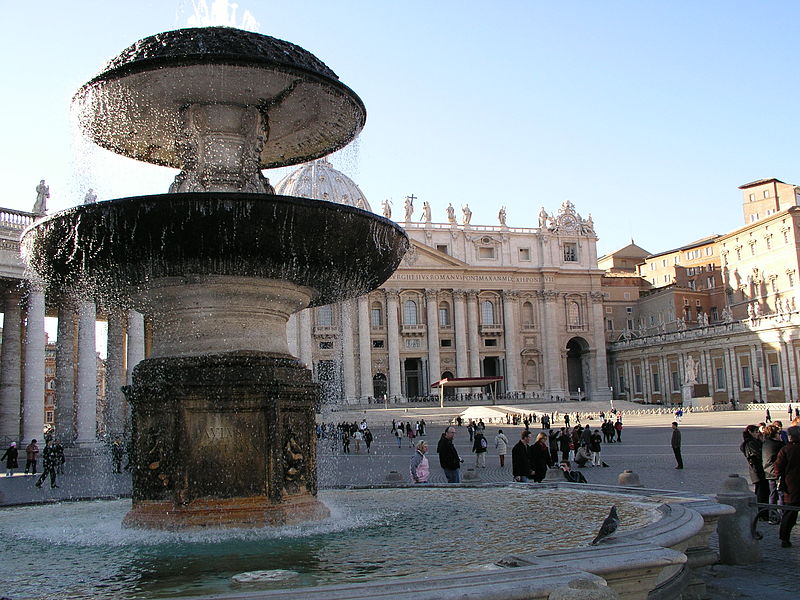
For half a century the square was decorated only by the Maderno Fountain and the obelisk raised by Pope Sixtus V, the southern part of the square was empty. In 1667 Pope Clement X commissioned Bernini to build a second fountain, which closely followed the design of the earlier fountain.
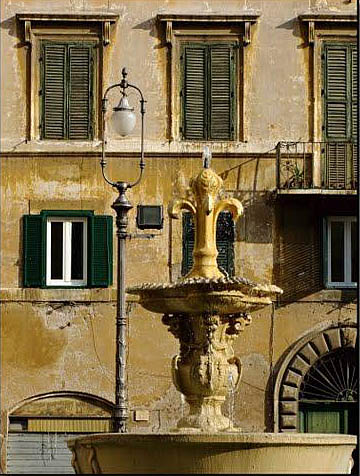
The granite stone basins of the two identical fountains are believed to come from the ancient Roman Baths of Caracalla. The emblems on the upper part of the fountain are those of the Farnese family, and the builder of the Palazzo, Cardinal Alessandro Farnese, later Pope Paul III.
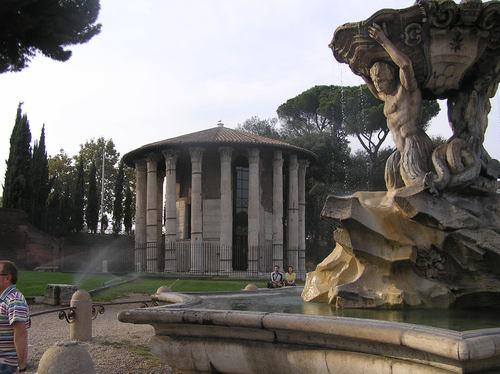
The Neptune fountain in front of Santa Maria in Cosmedin with the Temple of Hercules also known as Temple of the Vestal Virgins - in the background. - In Roman times this square was called Forum Boarium, the "Bulls' Forum"
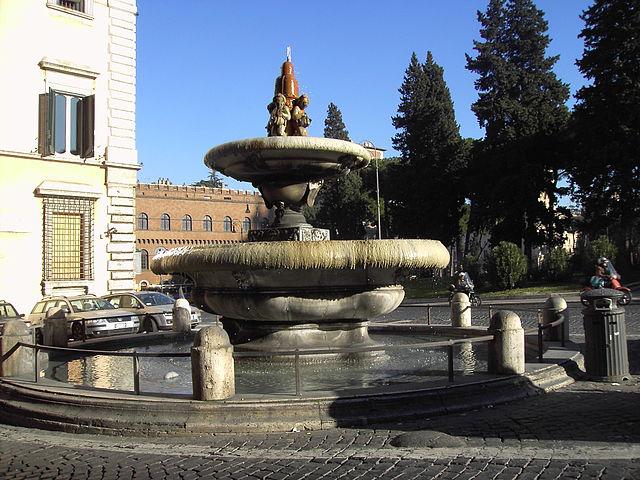
It is one of the first, and simplest, of Renaissance fountains that embellishes the city. Two circular basins capture the water, the top ringed by children pouring water from jugs, while above them is the heraldic symbol of the papal family. Commissioned by Pope Sixtus V in 1589, the fountain was designed by Giacomo della Porta and constructed by Andrea Brasca, Pietro Gucci and Pace Naldini.
During the 19th century the fountain underwent restoration.
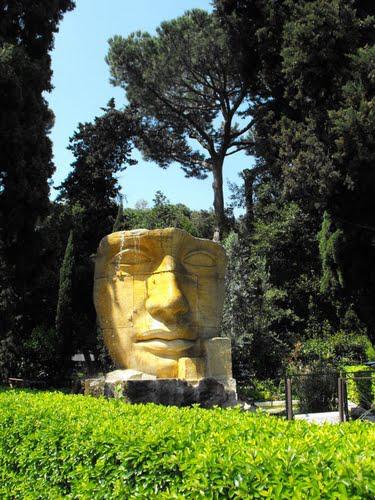
Fontana della Dea Roma by Igor Mitoraj (born
1944), Piazza Monte Grappa
This and the following fountain are two
of the very few
contemporary public monuments of the past 10 years in Rome
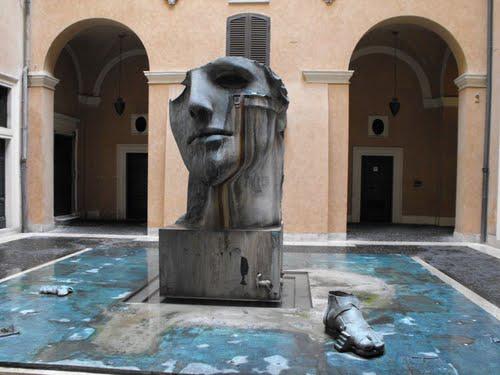
Fontana della Dea Roma by Igor Mitoraj in the courtyard of Palazzo
Mignanelli
A Video
of work by Polish sculptor Igor Mitoraj in Italy